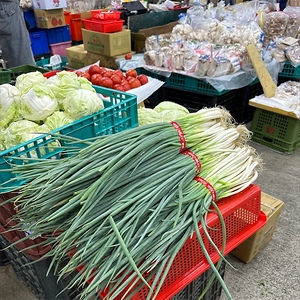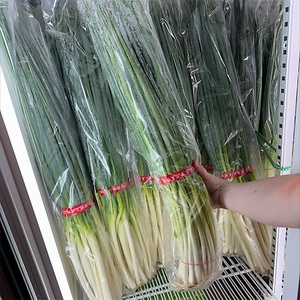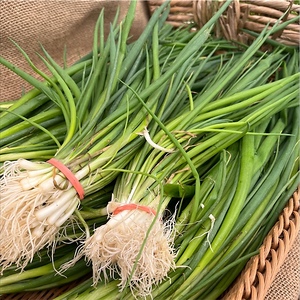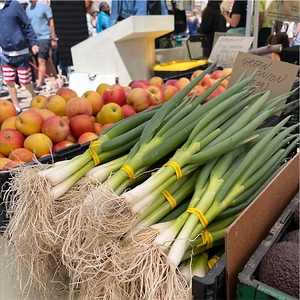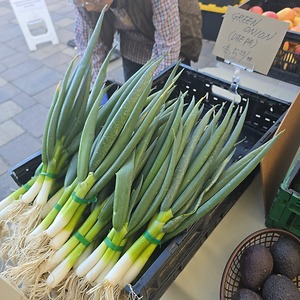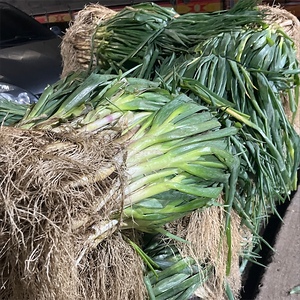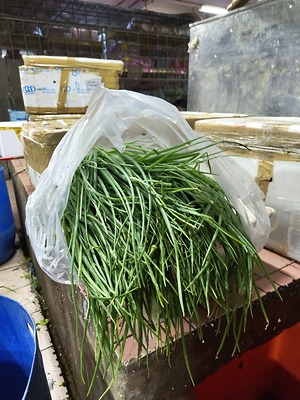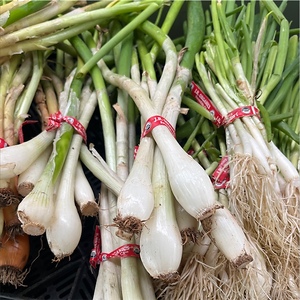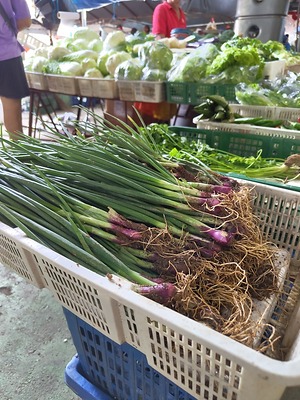

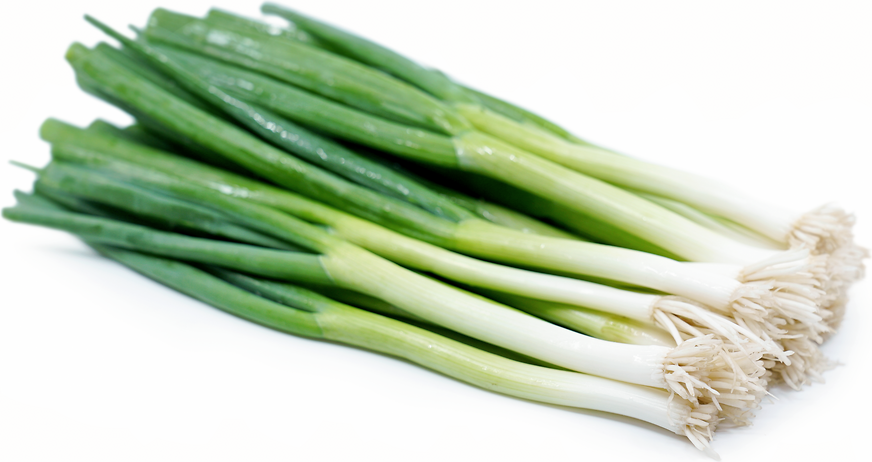
Green Onions
Estimated Inventory, 48 ct : 99.73
This item was last sold on : 07/29/25
Description/Taste
Green onions vary in size, depending on the specific variety, and are generally comprised of elongated, cylindrical pseudostems with tubular leaves. Each onion is firm, straight, and narrow, and the leaves grow directly from the base. The leaves range in color from light to dark green and are mostly hollow at the top with a striated, thick, and fibrous feel. The onion’s base is white, smooth, crisp, and lightly aqueous, made up of compact, tight layers. There are also tufts of white to light brown roots extending from the base. Green onions are crunchy, subtly chewy, and succulent when raw. If cooked, they soften in texture and become crisp and tender. One of the defining characteristics of Green onions is their versatility. The entire onion is edible, and the leaves will contribute different flavors and textural elements compared to the plump, white bases. Green onions release a faintly savory, onion-like aroma and have a refreshing, grassy, vegetal, sweet, and slightly pungent flavor. The white portions of the onion will have a sharper taste than the milder green leaves. Cooking the onions will also mellow their overall flavor and enhance sweetness.
Seasons/Availability
Green onions are available year-round, with a peak season in the spring and early summer.
Current Facts
Green onions are botanically part of the Allium genus and the Amaryllidaceae family. Many varieties are encompassed under the Green onion moniker, and these onion types belong to the species Allium cepa and Allium fistulosum. Some varieties of Green onions are harvested young before a bulb appears, while other cultivars are selectively bred to never produce a bulb. Green onions have been utilized as a culinary and medicinal crop since ancient times, and the herbaceous plants are traditionally harvested by hand. Worldwide, Green onions are also known as Scallions, Salad onions, and Bunching onions and the young, tender onions are favored for their versatility, mild flavor, and textural characteristics. Green onions are a widely grown commercial crop and are sold as a common ingredient for cuisines around the world. Chefs and home cooks seek the onions for use in fresh and cooked culinary preparations.
Nutritional Value
Green onions are a source of fiber to regulate the digestive tract and potassium to balance fluid levels within the body. Onions also provide vitamins A, B, C, and K to maintain healthy organs, strengthen the immune system, and aid in faster wound healing. Other nutrients include iron to develop the protein hemoglobin for oxygen transport through the bloodstream, magnesium to control nerve functions, calcium and phosphorus to support bones and teeth, zinc, manganese, and folate. Green onions are used in natural medicines for their anti-inflammatory and antioxidant properties.
Applications
Green onions have a mildly pungent, green, and vegetal flavor suited for fresh and cooked preparations. Each variety of Green onion will vary in intensity, but most young onions have a mellower taste than mature onions, allowing them to be used in a wide array of culinary dishes. Green onions can be used in their entirety, and it is recommended that the exterior layer be peeled and the leaves gently washed before use. Once prepped, Green onions can be chopped and added to salads or used as a fresh topping. Green onion garnishes add texture, color, and flavor, and their mild onion-like taste enhances savory dishes. Try mincing Green onions into dips, sauces, dressings, and relishes. Salsa and pesto are two popular condiments that incorporate Green onions. In addition to fresh preparations, Green onions can also be gently cooked. Adding Green onions towards the end of the cooking process is recommended to preserve their crisp texture. Green onions can be stirred into noodle and rice dishes or minced into fillings for wontons, dumplings, and rolls. In Asia, green onions are often added to fried pancakes as a snack. The flavorful leaves are also simmered into soups, curries, and stews. Beyond cutting Green onions into smaller pieces, the greens can be sauteed whole in olive oil or grilled for a smokier flavor. Green onions can be used in any preparation calling for onions, like omelets, cornbread recipes, or pasta dishes. They can also be cooked into legume-based meals, finely chopped into meatballs, or pickled as a tangy condiment. Green onions pair well with snow peas, chard, broccoli, radishes, carrots, herbs such as basil, parsley, and cilantro, and meats such as pork, poultry, beef, and turkey. Whole, unwashed Green onions will last 3 to 7 days when wrapped in a paper towel and stored in the refrigerator’s crisper drawer.
Ethnic/Cultural Info
Green onions are a traditional element incorporated into Passover Seder among the Jewish community of Iranian and Persian descent. Passover Seder is held on the first and sometimes second night of Passover, typically in the spring, and commemorates the story of the Israelites' freedom and exodus from Egypt. Seder is a meal comprised of six symbolic items that are acknowledged and consumed at specific times. During the Dayenu, which is a song recited during the Passover Seder, it is customary for Persian and Iranian Jews to playfully hit their friends and families with Green onions. Dayenu translates from Hebrew to mean “it would have been enough” and is a time to remember the historical and spiritual importance of Passover while also being mindful of how life is being lived in the present. The history of using Green onions in Seder is unknown, but it is said that the onions symbolize the whips that the Egyptians used to control the Israelites. Hitting other Seder participants is meant to enforce the ideal of never longing for the past and times of afflictions. It is also a physical way for the Jews to understand the suffering that their ancestors experienced in Egypt. Despite the solemn symbolism, the custom of throwing Green onions is a favorite element of Passover Seder, and Jews of all ages participate and enjoy the activity.
Geography/History
Green onions have a widespread history, as many varieties are broadly categorized under this name. Most varieties sold under the Green onion descriptor belong to Allium cepa and Allium fistulosum. Allium cepa types are thought to be native to Central Asia, while Allium fistulosum varieties are descendants of wild plants native to Eastern Asia. The exact history of Green onions is unknown, but it is hypothesized that young onions have been utilized in culinary and medicinal preparations since ancient times. Onions were an early cultivated crop in history, and as different varieties were selectively bred for improved traits, the versatility of the plants also increased. The movement of Green onions worldwide mirrors the history of onions in general. Several Green onion varieties were created and widely used in cuisines across Asia, and over time, their presence in cooking appeared throughout Europe and the Americas. New hybrid varieties were also eventually bred between Allium cepa and Allium fistulosum to create tender onions that do not form bulbs. Today, Green onions are extensively cultivated in Asia, primarily in China, Korea, Japan, Taiwan, and parts of Southeast Asia. They are also commercially grown worldwide in the Americas, Europe, Africa, and Australia. Green onions thrive in tropical, subtropical, and temperate climates and are sown multiple times to produce year-round availability. The tender onion varieties are sold in bunches through fresh markets, retailers, grocers, and distributors worldwide.
Featured Restaurants
Restaurants currently purchasing this product as an ingredient for their menu.
| Love Boat Sushi-Oceanside | Oceanside CA | 760-721-3737 |
| Seneca | San Diego CA | 619-588-2411 |
| Morning Glory | San Diego CA | 619-629-0302 |
| Sisters Pizza | San Diego CA | 858-228-6822 |
| Cody's La Jolla | La Jolla CA | 858-459-0040 |
| Marriott Gaslamp | San Diego CA | 619-696-0234 x6051 |
| Coral Del Mar | Del Mar CA | 858-449-6679 |
| Barleymash | San Diego CA | 619-255-7373 |
| Vista Valley | Vista CA | 760-758-2800 |
| Stake Chophouse & Bar | Coronado CA | 619-522-0077 |
| Coast Catering | Escondido CA | 619-295-3173 |
| Comedor Nishi | La Jolla CA | 619-549-9919 |
| Institutes of Health LLC | San Diego CA | 800-270-5016 |
| Craft and Commerce (Sekscobra Inc.) | San Diego CA | 619-962-5935 |
| Shimbashi Izakaya | Del Mar CA | 858-523-0479 |
| Brigantine Del Mar | Del Mar CA | 858-481-1166 |
| Shore Rider | La Jolla CA | 858-412-5308 |
| Jake's Del Mar | Del Mar CA | 858-755-2002 |
| Artifact at Mingei | San Diego CA | 619-846-2164 |
| Top of the Market | San Diego CA | 619-234-4867 |
| Under Belly-Little Italy Kitchen | San Diego CA | 619-269-4626 |
| Jeune Et Jolie | Carlsbad CA | 858-231-0862 |
| Pacific Cafe & Catering (Medical Cntr Dr.) | La Jolla CA | 619-808-4087 |
| WaterBar | San Diego CA | 619-308-6500 |
| Make Stuff Good | San Diego CA | 949-547-9470 |
| The Promiscuous Fork-La Jolla Blvd | La Jolla CA | 858-776-3246 |
| Panama 66 | San Diego CA | 619-206-6352 |
| Miguel's Cocina Pt Loma | San Diego CA | 619-224-2401 |
| Fort Oak | San Diego CA | 619-795-6901 |
| The Joint | San Diego CA | 619-222-8272 |
| Smoking Gun | San Diego CA | 619-276-6700 |
| Lodge at Torrey Pines Grill | San Diego CA | 858-453-4420 |
| HiroNori Ramen | San Diego CA | 619-446-9876 |
| The Santaluz Club Inc - Bistro Kitchen | San Diego CA | 858-759-3150 |
| Park Hyatt Aviara (Ember & Rye) | Carlsbad CA | 760-448-1234 |
| Happy Medium SD | San Diego CA | 509-869-2279 |
| La Dona | San Diego CA | 858-352-8134 |
| MCRD-Marine Corps Recruit Dept | San Diego CA | 619-725-6478 |
| Firefly Beach | San Diego CA | 619-222-6440 |
| The Cottage La Jolla | La Jolla CA | 858-454-8408 |
| The Hop Stop | Poway CA | 858-859-2669 |
| Nishiki Ramen - Mira Mesa | San Diego CA | 808-561-1090 |
| Marriott Courtyard Old Town | San Diego CA | 619-260-8500 |
| Haru Holdings (Bun Section) | Carlsbad CA | 619-613-7909 |
| Belmont Park Draft | San Diego CA | 858-228-9283 |
| Shootz Fish X Beer (Carlsbad) | Carlsbad CA | 760-450-8070 |
| Common Theory Chula Vista | Chula Vista CA | 619-495-3689 |
| Cove House | La Jolla CA | 858-999-0034 |
| Paradisaea Restaurant | La Jolla CA | 732-915-6669 |
| Leu Leu | Leucadia CA | 619-316-5807 |
| Ridgeview Health Center | San Diego CA | 858-293-3950 |
| La Jolla Beach & Tennis Club | San Diego CA | 619-816-8319 |
| Relic Bageri LLC | San Diego CA | 619-335-6328 |
| The Field Irish Pub & Restaurant | San Diego CA | 619-232-9840 |
| Vagabond Sportfishing Inc. | San Diego CA | 619-993-9575 |
| The Switchboard Restaurant 2024 | Oceanside CA | 760-279-6300 |
| Herb & Sea | Encinitas CA | 858-587-6601 |
| Coronado Yacht Club | Coronado CA | 619-435-1848 |
| Uptown Tavern | San Diego CA | 619-683-9322 |
| UCSD Food & Nutrition Department La Jolla | San Diego CA | 858-761-1269 |
| Sushi Kami | San Diego CA | 858-451-7799 |
| Urban Kitchen Catering | San Diego CA | 619-276-8803 |
| Carte Hotel | San Diego CA | 619-365-1858 |
| Pizza Kaiju | San Diego CA | 619-240-2716 |
| Crudo Cevicheria & Oyster Bar | San Diego CA | 619-313-9127 |
| Maderas Golf Club | Poway CA | 858-451-8100 |
| Hane | San Diego CA | 619-339-6438 |
| Wolf In the Woods | San Diego CA | 619-851-7275 |
| Common Theory | San Diego CA | 858-384-7974 |
| Nutmeg Bakery & Cafe 1 | San Diego CA | 858-405-2401 |
| Kensington Cafe | San Diego CA | 619-684-0044 Fausto |
| Chef Drew Mc Partlin | San Diego CA | 619-990-9201 |
| Juniper & Ivy | San Diego CA | 858-481-3666 |
| The Crack Shack-Encinitas | Encinitas CA | 877-230-1871 |
| Beach Terrance Inn | Carlsbad CA | 760-729-5951 |
| The Crack Shack PB | San Diego CA | 619-450-7978 |
| Glenbrook Health Center | Carlsbad CA | 760-704-1000 |
| Gravity Heights Restaurant and Brewery | San Diego CA | 858-551-5105 |
| My Five Star Chef | La Jolla CA | 619-890-1159 |
| La Costa Resort & Spa Main Kitchen | Carlsbad CA | 760-930-7063 |
| Harmony Cuisine 2B1 | San Diego CA | 858-737-4777 |
| Crust & Brew | San Diego CA | 858-212-8751 |
| Sandpiper Wood Fired Grill & Oysters | La Jolla CA | 858-228-5655 |
| Pokewan (Del Mar) | San Diego CA | 858-847-2881 |
| Wayfarer Bread | La Jolla CA | 805-709-0964 |
| Zoya | La Jolla CA | 619-942-3396 |
| Junkyard Sports Bar and Grill | Oceanside CA | 760-407-8500 |
| Harney Sushi | San Diego CA | 619-295-3272 |
| Palmys | San Diego CA | 858-886-7111 |
| Brigantine Coronado | Coronado CA | 619-435-4166 |
| Sheraton Carlsbad (7 Mile) | Carlsbad CA | 760-827-2400 |
| Hilton La Jolla Torrey Pines | La Jolla CA | 858-450-4581 |
| Brigantine Pt Loma | San Diego CA | 619-224-2871 |
| Culinary Kitchen Catering and Events | Coronado CA | 619-798-8477 |
| Home & Away - Old Town | San Diego CA | 619-886-1358 |
| Toast Catering | San Diego CA | 619-795-9135 |
| Blind Lady | San Diego CA | 619-381-4475 |
| Lafayette Hotel - Quixote | San Diego CA | 619-296-2101 |
| Fresh Sushi Catering | Carlsbad CA | 858-344-7098 |
| San Diego Yacht Club | San Diego CA | 619-758-6334 |
| Fortunate Son | San Diego CA | 619-806-6121 |
| Tartine | Coronado CA | 619-435-4323 |
| Casero Taqueria | Carlsbad CA | 760-533-4997 |
| Brigantine La Mesa | La Mesa CA | 619-465-1935 |
| Hyatt Islandia | San Diego CA | 619-224-1234 |
| Harvest Kitchen | Vista CA | 619-709-0938 |
| Portside Pier (TopSail) | San Diego CA | 858-268-1030 |
| Louisiana Purchase | San Diego CA | 619-255-8278 |
| Miguel's Cocina Carlsbad | Carlsbad CA | 760-759-1843 |
| The Original 40 Brewing | San Diego CA | 619-206-4725 |
| Hilton Garden Inn - Homewood Suites San Diego | San Diego CA | 619-696-6300 |
| El Sueno (TAKO) | San Diego CA | 619-972-6286 |
| Harney Sushi Oceanside | Oceanside CA | 760-967-1820 |
| Bar Same Same (Kitchen) | Carlsbad CA | 760-470-9143 |
| Nolita Hall | San Diego CA | 619-618-8820 |
| Communion | San Diego CA | 619-606-5568 |
| PFC Fitness Camp | Carlsbad CA | 888-488-8936 |
| Waverly | Cardiff CA | 619-244-0416 |
| Something Homemade | Vista CA | 858-245-1004 |
| Sonny's Pizza | San Diego CA | 619-432-1838 |
| Luce | San Diego CA | 619-275-2094 |
| Menya Ultra (La Jolla) | San Diego CA | 619-632-2704 |
| Fox Point Farms (Bakery) | Encinitas CA | 619-892-0553 |
| Belmont Park Cannonball | San Diego CA | 858-228-9283 |
| Fish & Things Poke Bar | San Diego CA | 916-995-1555 |
| Marriott Courtyard Nolen | San Diego CA | 619-544-1004 |
| Fishery | San Diego CA | 858-272-9985 |
| Lauberge Del Mar | Del Mar CA | 858-259-1515 |
| Solterra Winery + Kitchen | Encinitas CA | 858-245-6146 |
| El Sueno | San Diego CA | 619-972-6286 |
| Ju-Ichi | San Diego CA | 619-800-2203 |
| The Flavor Chef (Catering) | Vista CA | 619-295-3172 |
| Far Corner | San Diego CA | 619-549-0838 |
| Buon Appetito | San Diego CA | 619-238-9880 |
| Temaki | Encinitas CA | 702-489-2129 |
| Joya Kitchen | San Diego CA | 619-255-5979 |
| Kona Kai Resort and Marina | San Diego CA | 619-221-8000 |
| Donna Jean | San Diego CA | 619-392-0052 |
| Rubicon Deli India Street | San Diego CA | 619-200-4201 |
| Urbn Pizza Kitchen | San Diego CA | 619-255-7300 |
| Hilton Mission Valley | San Diego CA | 619-543-9000 |
| Fifty Two Remedies | San Diego San Diego | 858-707-7016 |
| Crafted @ Minerva's Cafe | La Jolla CA | 858-699-4129 |
| Cocina De Barrio | San Diego CA | 760-840-1129 |
| Rustic Root Solana | Solana Beach CA | 619-955-5750 |
| Tin Leaf Fresh Kitchen | Carlsbad CA | 760-431-5323 |
| Common Stock | San Diego CA | 619-310-5298 |
| Four Seasons Residence Club | Carlsbad CA | 760-603-6360 |
| Park Hyatt Aviara | Carlsbad CA | 760-448-1234 |
| Rustic Root | San Diego CA | 619-232-1747 |
| Inn at Rancho Santa Fe (Banquet) | Rancho Santa Fe CA | 858-381-8289 |
| The Besta-Wan Pizza House | Cardiff CA | 805-231-2515 |
| Moniker Coffee Company (Bar Food) | San Diego CA | 916-945-6721 |
| Shoreside Support Boat | San Diego CA | 704-277-7929 |
| Cocina de Barrio NP | San Diego CA | 858-349-2313 |
| Dija Mara | Oceanside CA | 760-231-5376 |
| Bread & Cie Café | San Diego CA | 619-683-9322 |
| Peace Pies | San Diego CA | 619-618-6960 |
| Jo's Mission Hills Diner | San Diego CA | 619-417-3801 |
| US Grant Hotel Main | San Diego CA | 619-232-3121 |
| Monarch School (Nutrition Lab) | San Diego CA | 619-804-1766 |
| Hawaiian Fresh Seafood | San Diego CA | 858-299-8862 |
| Sheraton Carlsbad (Banquets) | Carlsbad CA | 760-827-2400 |
| The Shores | La Jolla CA | 858-459-8271 |
| Webbcreationfood LLC | San Diego CA | 619-829-9194 |
| Public House 131 | San Diego CA | 858-537-0890 |
| Siesel's Meats | San Diego CA | 619-275-1234 |
| The Remy | San Diego CA | 619-886-1358 |
| Sushi Nekosan | La Jolla CA | 858-999-0999 |
| Harumama Noodles & Buns (Vista) | Vista CA | 858-886-9909 |
| Leucadia Pizza Point Loma | San Diego CA | 619-295-2222 |
| Bica | San Diego CA | 619-669-5725 |
| Rancho Valencia New Restaurant | Del Mar CA | 858-756-1123 |
| Shogun Sportfishing | San Diego CA | 619-226-8030 |
| Harumama Noodles & Buns (Carlsbad) | Carlsbad CA | 760-637-5737 |
| Alexander's on 30th | San Diego CA | 858-774-3062 |
| UCSD Food & Nutrition Department Hillcrest | San Diego CA | 619-380-9840 |
| Inn at Rancho Santa Fe | Rancho Santa Fe CA | 858-381-8289 |
| Q&A Oyster Bar & Restaurant | Oceanside CA | 858-245-3780 |
| Animae | San Diego CA | 619-925-7908 |
| Bang on 5th | San Diego CA | 619-677-5650 |
| Reata Glen | Ladera Ranch CA | 949-545-2250 |
| Piatti | San Diego CA | 858-454-1589 |
| Jujus Kitchen | San Diego CA | 619-471-5342 |
| Campfire | Carlsbad CA | 760-637-5121 |
| Hasta Manana Cantina | San Diego CA | 619-276-6700 |
| Miss B's Coconut Club | San Diego CA | 858-381-0855 |
| The Beau Hotel | San Diego CA | 619-310-5160 |
| Green Dragon Tavern & Museum | Carlsbad CA | 760-797-5579 |
| Lil Piggy's | Coronado CA | 619-522-6890 |
| Town & Country Arlo | San Diego CA | 619-291-7131 |
| Cocina de Barrio Point Loma | San Diego CA | 858-349-2313 |
| Viewpoint Brewing Co. | Del Mar CA | 858-205-9835 |
| Bleu Boheme | San Diego CA | 619-255-4167 |
| Lafayette Hotel - Beginners Diner | San Diego CA | 619-296-2101 |
| Pete's Seafood and Sandwich | San Diego CA | 619-852-1493 |
| Coin-Op Game Room (North Park) | San Diego CA | 818-448-0129 |
| Lilo | Carlsbad CA | 619-385-0914 |
| Stone Brewing World Bistro & Gardens | Escondido CA | 915-861-2297 |
| Kappa Sushi | San Diego CA | 858-566-3388 |
| Kairoa Brewing Company | San Diego CA | 858-735-0051 |
| Scion Health | Escondido California | 442-277-6167 |
| Starlite Kitchen | San Diego CA | 619-358-9766 |
| Boujiemana (La Maison) | San Diego CA | 415-710-0510 |
| Bayhill Tavern | San Diego CA | 858-288-6923 |
| Bernardo Heights Country Club | San Diego CA | 858-487-4022 |
| Pendry SD | San Diego CA | 619-738-7000 |
| Copper Kings | San Marcos CA | 323-810-1662 |
| The Monsaraz | San Diego CA | 858-760-6228 |
| LANA | Solana Beach CA | 602-758-2596 |
| The Country Club Of Rancho Bernardo | San Diego CA | 858-487-1134 |
| Fernside | San Diego CA | 619-398-5156 |
| KI's | Encinitas CA | 760-586-8289 |
| Prey Brewing Company | Vista CA | 760-822-4226 |
| Le Coq | La Jolla CA | 858-427-1500 |
| The Mission MB | San Diego CA | 858-488-9060 |
| Giuseppe Restaurants & Fine Catering | San Diego CA | 619-436-7006 |
| Corbeaux Wine & Tea House | Temecula CA | 909-567-6109 |
| Alila Marea Beach Resort | Encinitas CA | 805-539-9719 |
| Comma | San Diego CA | 619-802-9183 |
| Lucky Bolt | San Diego CA | 662-832-3638 |
| Hawaiian Fresh Seafood - Poway | Poway CA | 858-299-8862 |
| Steady State Roasting | Carlsbad CA | 760-908-1680 |
| Deeply Nourished | La Jolla CA | 808-489-7366 |
| Terra Restaurant | San Diego CA | 619-293-7088 |
| Saiko Sushi-Coronado | Coronado CA | 619-435-0868 |
| Blue Ocean La Jolla | La Jolla CA | 858-999-0323 |
| The Harvest Honey | San Marcos CA | 616-914-0124 |
| Harumama Sushi & Ramen (Ocean Beach) | San Diego CA | 858-886-9909 |
| Milton's Delicatessen, Grill & Bakery | Del Mar CA | 858-792-2225 |
| Nishiki Ramen | San Diego CA | 858-987-0222 |
| Belching Beaver Brewery Tavern and Grill | Vista CA | 760-509-4424 |
| Marriott Del Mar | San Diego CA | 858-369-6029 |
| Gold Finch | San Diego CA | 619-804-2051 |
| Pacific Coast Grill | Solana Beach CA | 858-794-4632 |
| Flora Cafe | Bonita CA | 619-339-6604 |
| Sheraton La Jolla | San Diego CA | 858-453-5500 |
| Menya Ultra (Clairemont) | San Diego CA | 858-333-0256 |
| Order Fire Barbecue | Santee CA | 619-768-3986 |
| Espadin | Temecula California | 951-383-5585 |
| Food by Chef Ty | Vista CA | 424-278-8626 |
| Sepulveda Meats & Provisions | San Diego CA | 619-501-1878 |
| Extraordinary Desserts | San Diego CA | 619-294-2132 |
| Olive Tree Marketplace | San Diego CA | 619-224-0443 |
| The Morning Grove | Carlsbad CA | 7605000465 |
| Cutwater Spirits | San Diego CA | 619-672-3848 |
| Brigantine Corp | San Diego CA | 858 926 9644 |
| The Crack Shack Costa Mesa | Costa Mesa CA | 951-808-7790 |
| Sushi Freak-Middle Town | San Diego CA | 619-296-2500 |
| InterContinental Vistal Kitchen | San Diego CA | 619-501-9400 |
| Sushi Ota 2021 | San Diego CA | 858-270-5047 |
| Gravity Heights Mission Valley | San Diego CA | 619-384-5993 |
| Mabel's Gone Fishing | San Diego CA | 619-228-9851 |
| Miguel's Cocina Coronado | Coronado CA | 619-437-4237 |
| Belching Beaver Brewery - Pub 980 | Vista CA | 760-420-7764 |
| BFD-Big Front Door | San Diego CA | 619-723-8183 |
| Tipsy Crow | San Diego CA | 619-338-9300 |
| Mothership | San Diego CA | 858-342-3609 |
| Georges at the Cove | San Diego CA | 858-454-4244 |
| Counterpoint | San Diego CA | 619-564-6722 |
| Blue Ocean | Carlsbad CA | 760-434-4959 |
| Royal Polaris Sportfishing | San Diego CA | 619-226-8030 |
| Herb & Wood | San Diego CA | 520-205-1288 |
| Duke's La Jolla | La Jolla CA | 858-454-1999 |
| South O Brewing Catering | Oceanside CA | 925-381-5392 |
| Beaumont's | San Diego CA | 858-459-0474 |
| The Mission NP | San Diego CA | 619-220-8992 |
| Rosewood Social | San Juan Capistrano CA | 669-243-8403 |
| Bayside Landing | San Diego CA | 858-270-9200 |
| Mission Ave Bar and Grill | Oceanside CA | 760-717-5899 |
| Hotel La Jolla - Sea & Sky | La Jolla CA | 858-459-0261 |
| Nomad Donuts | San Diego CA | 619-431-5000 |
| The Lab Restaurant | Oceanside CA | 619-861-8299 |
| Humphrey's | San Diego CA | 619-224-3577 |
| Casa | San Diego CA | 619-581-3003 |
| Bali Hai Restaurant | San Diego CA | 619-222-1181 |
| Under Belly-Uptown | San Diego CA | 619-269-4626 |
| Burgeon Beer Co. | San Diego CA | 760-814-2548 |
| La Valle Coastal Club | Rancho Santa Fe CA | 858-759-5473 |
| Sushi Exchange | San Diego CA | 619-961-7218 |
| SIE Culinary Management | San Diego CA | 858-964-8677 |
| Addison Del Mar | Del Mar CA | 858-350-7600 |
| Hiddenfish | San Diego CA | 858-357-1109 |
| Blue Ocean Sushi & Grill (UTC) | San Diego CA | 858-886-9909 |
| Mister A's | San Diego CA | 619-239-1377 |
| Drift Cafe | San Diego CA | 858-263-4298 |
| Miguel's 4S Ranch | San Diego CA | 858-924-9200 |
| Kingfisher | San Diego CA | 619-861-8074 |
| Coya Peruvian Secret | Del Mar CA | 619-295-3172 |
| The Shout House | San Diego CA | 619-231-6700 |
| La Jolla Country Club | San Diego CA | 858-454-9601 |
| Rabbit Hole | San Diego CA | 619-255-4653 |
| The Guild Hotel | San Diego CA | 619-764-5108 |
| Stout Public House | San Diego CA | 619-702-7933 |
| Boujiemana (TCW) | San Diego CA | 415-710-0510 |
| Pitchers | San Diego CA | 858-472-1251 |
| Green Acres Campus | San Diego CA | 858-450-9907 |
| Storyhouse Spirits Bar | San Diego CA | 801-949-5955 |
| Great Maple Hillcrest | San Diego CA | 619-255-2282 |
| Del Mar Country Club | Rancho Santa Fe CA | 858-759-5995 |
| insideOUT | San Diego CA | 619-888-8623 |
| Kettner Exchange | San Diego CA | 909-915-9877 |
| Redwing Bar & Grill | San Diego CA | 619-281-8700 |
| The Lion Share | San Diego CA | 619-564-6924 |
| Miguel's Old Town | San Diego CA | 619-298-9840 |
| Plant Based Meals | San Diego CA | 858-255-0590 |
| The Haven (Pizzeria) | San Diego CA | 619-964-3778 |
| Eddie V's La Jolla - EV# 8511 | La Jolla CA | 858-459-5500 |
| Bishop School | San Diego CA | 858-459-4021 |
| Cloak and Petal | San Diego CA | 626-319-6878 |
| Salt & Whiskey | San Diego CA | 619-544-1886 |
| Convention Center Shell | San Diego CA | 619-954-3063 |
| Brigantine Imperial Beach | Imperial Beach CA | 619-591-1350 |
| Park Commons - ARE | San Diego CA | 619-295-3172 |
| Fay's Diner and Cafe | San Diego CA | 661-858-8895 |
| Mavericks Beach Club | San Diego CA | 858-999-0348 |
| Crest Cafe | San Diego CA | 619-295-2510 |
| Olivewood Gardens and Learning Center | National City CA | 619-434-4281 |
| RoVino Rotisserie + Wine | San Diego CA | 619-972-6286 |
| Brigantine Poway | Poway CA | 858-486-3066 |
| Savory Moment (1) | Carlsbad CA | 619-633-8863 |
| The Farm Golf Club | Rancho Santa Fe CA | 858-756-5585 |
| The Britannia Tearooms | San Diego CA | 619-683-2748 |
| Tom Hams Light House | San Diego CA | 619-291-9110 |
| Peace Pies (Encinitas) | Encinitas CA | 619-618-6960 |
| Moxy San Diego Gaslamp | San Diego CA | 619-376-1850 |
| Crust Pizzeria Solana Beach | Solana Beach CA | 858-212-8751 |
| Coco Maya by Miss Bs | San Diego CA | 858-245-3780 |
| Turf Supper Club | San Diego CA | 619-234-6363 |
| Ctzn | Solana Beach CA | 858-925-7141 |
| Camino Riviera | San Diego CA | 619-685-3881 |
| The Glen at Scripps Ranch | San Diego CA | 858-444-8500 |
| The Bower | Coronado CA | 949-212-3192 |
| Hawaiian Fresh Seafood - LS | San Diego CA | 858-299-8862 |
| UCSD Health East campus | San Diego CA | 619-578-3373 |
| Farm Fresh Meals | Vista CA | 760-707-2383 |
| The Kitchen at MCASD | La Jolla CA | 619-880-8719 |
| Tribute Pizza | San Diego CA | 858-220-0030 |
| Southwestern Yacht Club | San Diego CA | 619-222-0438 |
| Justin Hoehn | San Diego CA | 619 326 8895 |
| Culinary Concepts | San Diego CA | 619-865-1918 |
| Tap Room Beer Co. | San Diego CA | 619-539-7738 |
| Portside Pier (Miguels) | San Diego CA | 858-268-1030 |
| Manhattan of La Jolla | La Jolla CA | 858-459-0700 |
| Himitsu | La Jolla CA | 858-345-0220 |
| Jalisco Cantina | Carlsbad CA | 619-204-5945 |
| Choi's | San Diego CA | 858-900-1224 |
| Farmer and The Seahorse | San Diego CA | 619-302-3682 |
| Miho | San Diego CA | 619-365-5655 |
| My Chef | San Diego CA | 916-217-0049 |
| Nunu's Tavern | San Diego CA | 619-756-4009 |
| Hilton Garden Inn | San Diego CA | 858-720-9500 |
| Lumi | San Diego CA | 619-955-5750 |
| One Door North | San Diego CA | 858-232-4220 |
| Sandbar Sports Grill | San Diego CA | 858-488-1274 |
| Leichtag Foundation | Encinitas CA | 760-230-6772 |
| Tahona (Kitchen) | San Diego CA | 619-573-0289 |
| The Corner Drafthouse | San Diego CA | 619-255-2631 |
| The Market by Buon Appetito | San Diego CA | 619-237-1335 |
| Third Corner Ocean Beach | San Diego CA | 619-223-2700 |
| Harumama (Little Italy) | San Diego CA | 619-269-7122 |
| Tavern at the Beach | San Diego CA | 858-272-6066 |
| Menya Ultra (Mira Mesa) | San Diego CA | 619-889-4566 |
| Blue Whale | La Jolla CA | 808-868-8639 |
| Born & Raised | San Diego CA | 619-944-1631 |
| Sheraton Carlsbad (20/20) | Carlsbad CA | 760-827-2400 |
| Searcher Sportfishing | San Diego CA | 619-861-4640 |
| Botanica | San Diego CA | 619-310-6320 |
| The Plot Restaurant (Costa Mesa) | Costa Mesa CA | 714-852-3181 |
| Extraordinary Desserts Union St. | San Diego CA | 619-294-7001 |
| Bernini's Bistro | La Jolla CA | 858-454-5013 |
| The Roxy Encinitas | Encinitas CA | 760-230-2899 |
| Ketch Grill and Taps | San Diego CA | 858-268-1030 |
| The Local-Pacific Beach | San Diego CA | 858-263-7475 |
| Wormwood | San Diego CA | 619-573-0289 |
| Coin-Op Game Room (Downtown) | San Diego CA | 619-255-8864 |
| Sovereign Thai Cuisine | San Diego CA | 619-887-2000 |
| Oliver & Rose | San Diego CA | 619-300-3395 |
| Pacific Regent La Jolla | San Diego CA | 858-597-8008 |
| Sets Kitchen and Bar | San Marcos CA | 970-390-2148 |
| The Victorian at Hill Street | Oceanside CA | 442-266-8285 |
| Cocina de Barrio Encinitas | Encinitas CA | 760-840-1129 |
| Parkhouse Eatery | San Diego CA | 619 295 7275 |
| Nobu | San Diego CA | 619-814-4124 |
| Manna | Encinitas CA | 510-366-3057 |
| Leucadia Pizza Scripps Ranch | San Diego CA | 858-530-2222 |
| Sbicca Del Mar | Del Mar CA | 619-417-2587 |
| Vinya: Vino & Vinyasa | San Diego CA | 858-703-8101 |
| University Club | San Diego CA | 619-234-5200 |
| Blue Water Estate Services | Rancho Santa Fe CA | 858-720-9831 |
| Encontro North Park | San Diego CA | 310-955-6333 |
| Harley Gray Kitchen and Bar | San Diego CA | 619-840-7000 |
| The Crossings | Carlsbad CA | 760-444-1800 |
| Azuki Sushi Lounge | San Diego CA | 619-238-4760 |
| Bistro du Marche by Tapenade | La Jolla CA | 858-551-7500 |
| Crown Point Catering | San Diego CA | 619-223-1211 |
| Solana Beach Kitchen | Solana Beach CA | 610-717-7217 |
| Sandbox Pizza | San Diego CA | 858-272-7263 |
| Brockton Villa Restaurant | San Diego CA | 858-454-7393 |
| Little Victory Wine Market | Carlsbad CA | 310-738-3380 |
| Saint Mark Golf and Resort, LLC | San Marcos CA | 508-320-6644 |
| Pamplemousse Grill | Solana Beach CA | 858-792-9090 |
| Stone Brewing-Liberty Station | San Diego CA | 619-269-2100 |
| Single Fin Surf Grill | San Diego CA | 619-948-7873 |
| The Crack Shack-San Diego | San Diego CA | 619-795-3299 |
| Mitch's Seafood | San Diego CA | 619-316-7314 |
| Hotel Indigo | San Diego CA | 619-295-3172 |
| Kitchens for Good (SD) | San Diego CA | 619-450-4040 |
| Sago | Encinitas CA | 858-382-4047 |
| Rancho Valencia | Del Mar CA | 858-756-1123 |
| Lodge at Torrey Pines Main | San Diego CA | 858-453-4420 |
| Harney Poway Sushi | Poway CA | 760-533-0051 |
| Grass Skirt | San Diego CA | 858-412-5237 |
| Polaris Supreme | San Diego CA | 619-390-7890 |
| The Mission EV | San Diego CA | 619-232-7662 |
| Burning Beard | El Cajon CA | 619-884-4716 |
| Fresco Cocina | Carlsbad CA | 760-720-3737 |
| The Santaluz Club Inc - Main Dining | San Diego CA | 858-759-3150 |
| Matsu | Oceanside CA | 760-717-5899 |
| The Lion Share 2025 | San Diego CA | 619-564-6924 |
| PureTaco | Carlsbad CA | 760-845-3346 |
| The Bowl | San Diego CA | 619-813-5865 |
| Rancho Santa Fe Golf Club | Rancho Santa Fe CA | 858-756-1582 |
| Toast Cafe | San Diego CA | 858-208-9422 |
| The Santaluz Club Inc - Banquet | San Diego CA | 858-759-3150 |
| Brigantine Escondido | Escondido CA | 760-743-4718 |
Recipe Ideas
Recipes that include Green Onions. One



